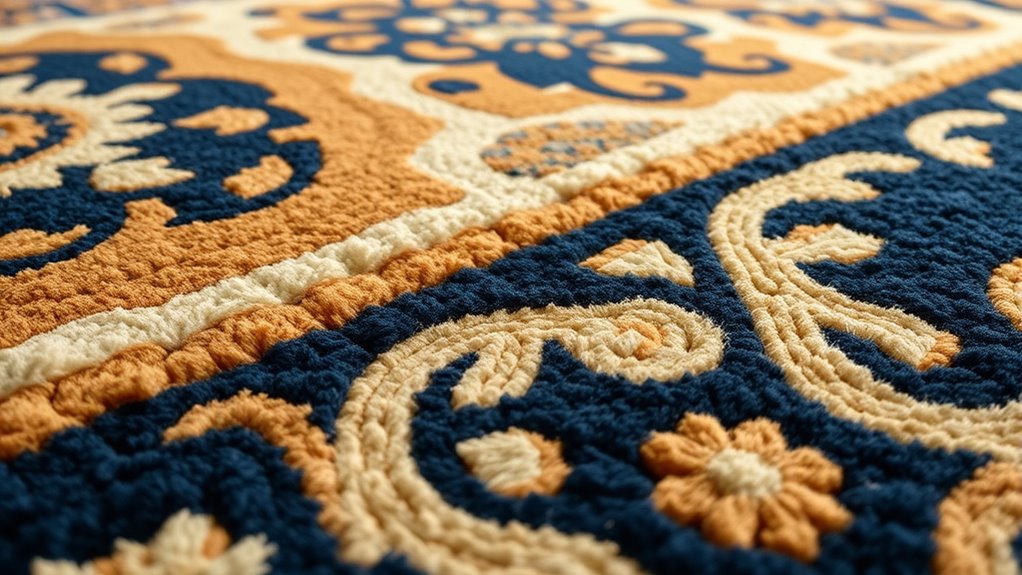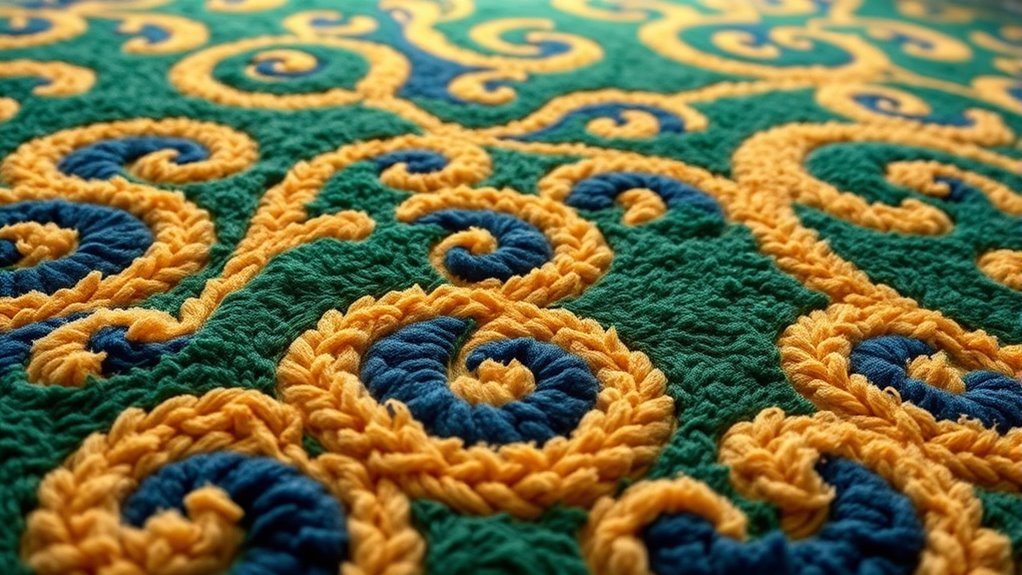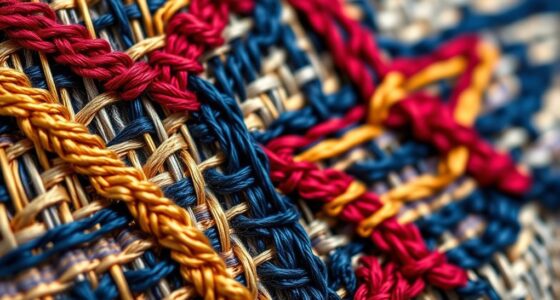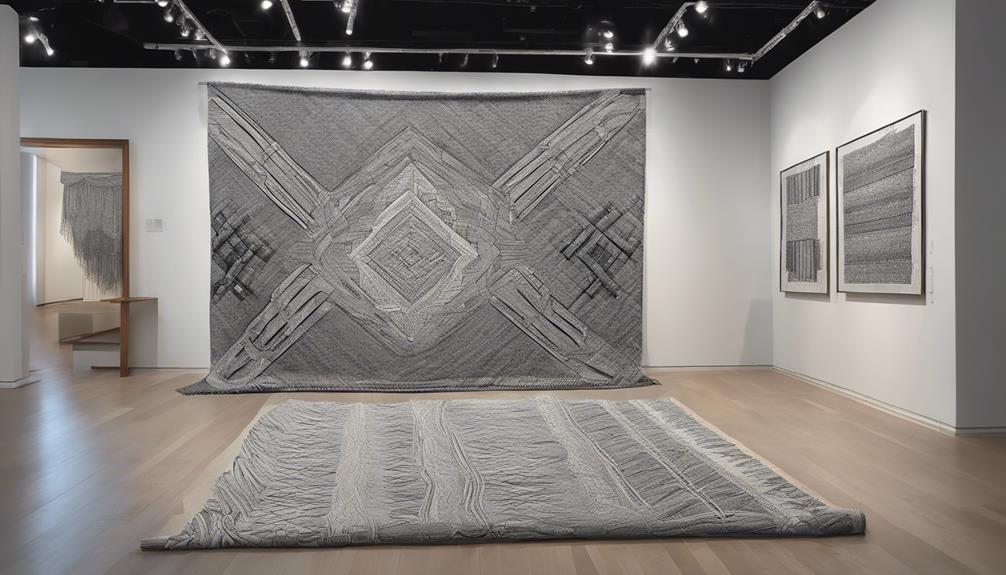Hand-tufted rugs are making a comeback because collectors now value craftsmanship, authenticity, and sustainability more than ever. They prefer natural fibers like wool and silk and appreciate vintage-inspired designs that combine history with modern trends. Restoring old rugs adds uniqueness, durability, and a story that increases their worth. If you want to explore how this movement affects the market and what drives the demand, keep exploring this exciting revival.
Key Takeaways
- Revival of authenticity and craftsmanship has increased demand for hand-tufted rugs among collectors.
- Use of natural, eco-friendly fibers aligns with sustainability trends, boosting their market value.
- Vintage techniques and restoration efforts add unique character, driving collector interest and higher prices.
- Restored rugs offer enhanced durability and authenticity, making them desirable investment pieces.
- The focus on craftsmanship and eco-conscious practices elevates the status and worth of hand-tufted rugs.

Have you noticed that hand-tufted rugs are making a comeback? It’s more than just a trend; it’s a shift driven by a desire for authenticity, sustainability, and craftsmanship. Today’s collectors are increasingly drawn to pieces made from sustainable materials, which not only look beautiful but also align with eco-conscious values. Hand-tufted rugs often incorporate natural fibers like wool, jute, or silk, making them a greener choice compared to machine-made alternatives. This focus on eco-friendly materials appeals to those who want their collections to reflect both style and social responsibility. Additionally, many artisans and designers are reviving vintage techniques and designs, infusing modern rugs with a sense of history and character that mass-produced pieces lack.
Vintage restoration plays a significant role in this resurgence. Restoring and reimagining old rugs isn’t just about saving a piece of history; it’s about transforming it into a contemporary work of art. When you invest in a vintage hand-tufted rug, you’re not only acquiring a unique aesthetic but also supporting sustainable practices. Restoring these rugs involves carefully repairing worn areas and sometimes updating dyes or fibers to meet modern standards, all while preserving the original craftsmanship. This process adds value and authenticity, making vintage hand-tufted rugs especially appealing to collectors who appreciate stories and history behind their pieces. Moreover, the meticulous process of vintage restoration enhances the rug’s durability and overall quality, further increasing its desirability and worth.
The appeal of these rugs extends beyond their eco-friendly materials and vintage charm. Their handcrafted nature means each piece carries a level of artistry that machines can’t replicate. When you examine a hand-tufted rug, you see the intricate knots, the careful attention to detail, and the skill of the artisan. These qualities make them highly collectible in a market that’s increasingly valuing craftsmanship and individuality. As more people recognize the importance of sustainability, the demand for vintage restoration and hand-crafted items grows. Collectors are willing to pay more for rugs that have both a compelling backstory and a commitment to environmentally friendly practices.
Furthermore, the timeless appeal of hand-tufted rugs ensures they remain a smart investment. Their durability, combined with the growing appreciation for sustainable materials and vintage restoration, means their value is likely to increase. Whether you’re looking to add a statement piece to your collection or seeking an eco-conscious way to decorate your space, hand-tufted rugs offer a compelling combination of artistry, history, and sustainability. It’s no wonder that more collectors are paying a premium for these pieces—they’re not just rugs; they’re a tribute to craftsmanship and responsible design.
Frequently Asked Questions
How Do Hand-Tufted Rugs Compare to Hand-Knotted Rugs?
When comparing hand-tufted rugs to hand-knotted rugs, you’ll find that hand-knotted rugs excel in rug craftsmanship, offering intricate designs and durability. Hand-tufted rugs are quicker and more affordable to produce, giving you more design versatility. While hand-knotted rugs often hold more value and showcase detailed artistry, tufted rugs provide a stylish, cost-effective option for your space, balancing quality with accessibility.
What Materials Are Commonly Used in Authentic Hand-Tufted Rugs?
You might be surprised, but authentic hand-tufted rugs typically use natural fibers like wool, cotton, or silk for durability and softness. Sometimes, though, they incorporate synthetic blends such as nylon or polyester to reduce costs and add resilience. This mix creates a versatile, vibrant rug that’s both beautiful and practical. Knowing the materials helps you identify quality and authenticity, ensuring your investment lasts and maintains its appeal over time.
Are Hand-Tufted Rugs Suitable for High-Traffic Areas?
You might wonder if hand-tufted rugs suit high-traffic areas. While they offer vibrant designs, durability concerns arise because they can wear faster with heavy use. However, choosing rugs with stain-resistant fibers can help mitigate stains and make maintenance easier. If you prioritize longevity and stain resistance, look for high-quality hand-tufted options, but be prepared for potential wear over time in busy spaces.
How Can I Authenticate a Vintage Hand-Tufted Rug?
To authenticate a vintage hand-tufted rug, start with a thorough backside inspection—look for irregularities in the tufting and backing that indicate handcrafting. Next, consider dye analysis; authentic vintage rugs often use natural dyes, which age beautifully and may fade unevenly. Combining these steps helps verify authenticity, ensuring you’re investing in a genuine piece. Be cautious of machine-made imitations that lack these authentic signs.
What Maintenance Is Required to Preserve Hand-Tufted Rugs?
To preserve your hand-tufted rug, you should regularly vacuum it to prevent dust buildup, but avoid harsh brushes that could damage the fibers. Keep it out of direct sunlight to prevent dye fading, and rotate it periodically for even wear. To prevent pests, use natural repellents or maintain a clean environment. Address spills immediately, and have it professionally cleaned every couple of years to keep it looking vibrant.
Conclusion
You see the resurgence of hand-tufted rugs, and you recognize their timeless appeal, their craftsmanship, and their cultural significance. You appreciate their intricate artistry, their unique textures, and their growing value. You understand why collectors chase after them, why investment meets tradition, and why beauty meets rarity. Embrace the craftsmanship, admire the history, and consider the future—because in the world of rugs, passion, artistry, and investment all intertwine, making these pieces truly extraordinary.










